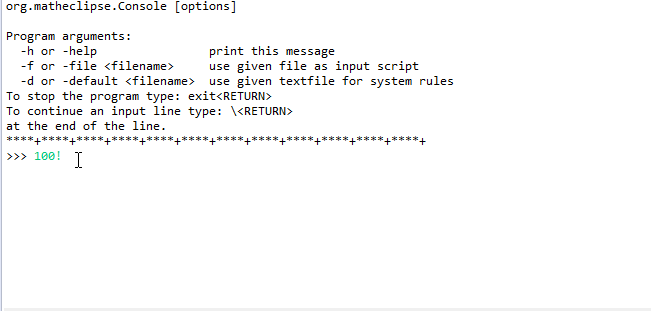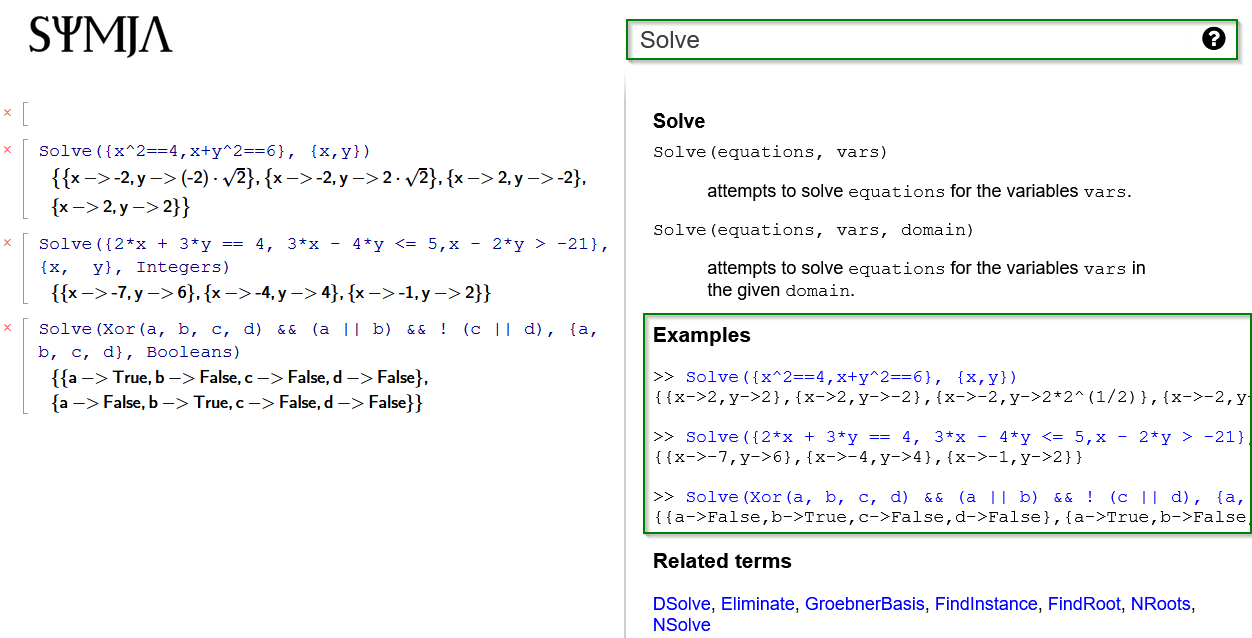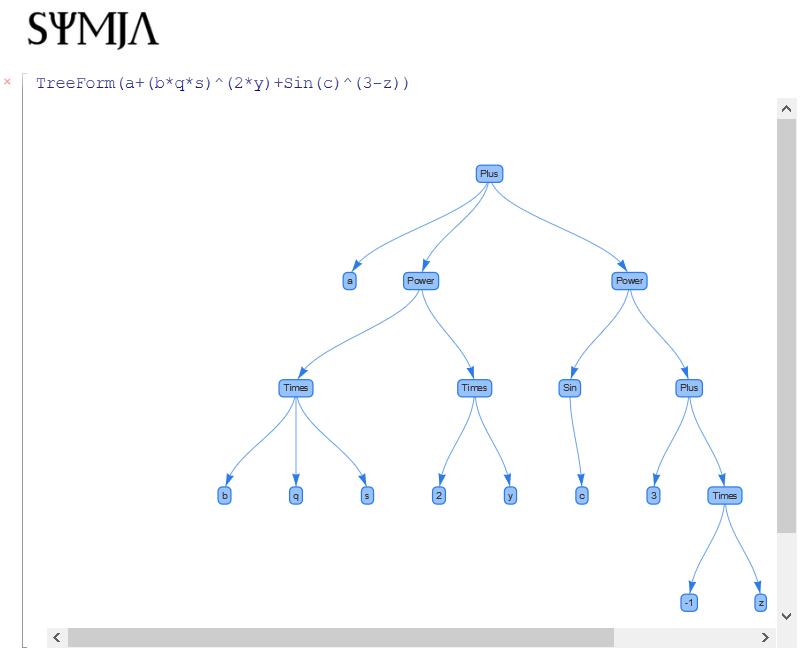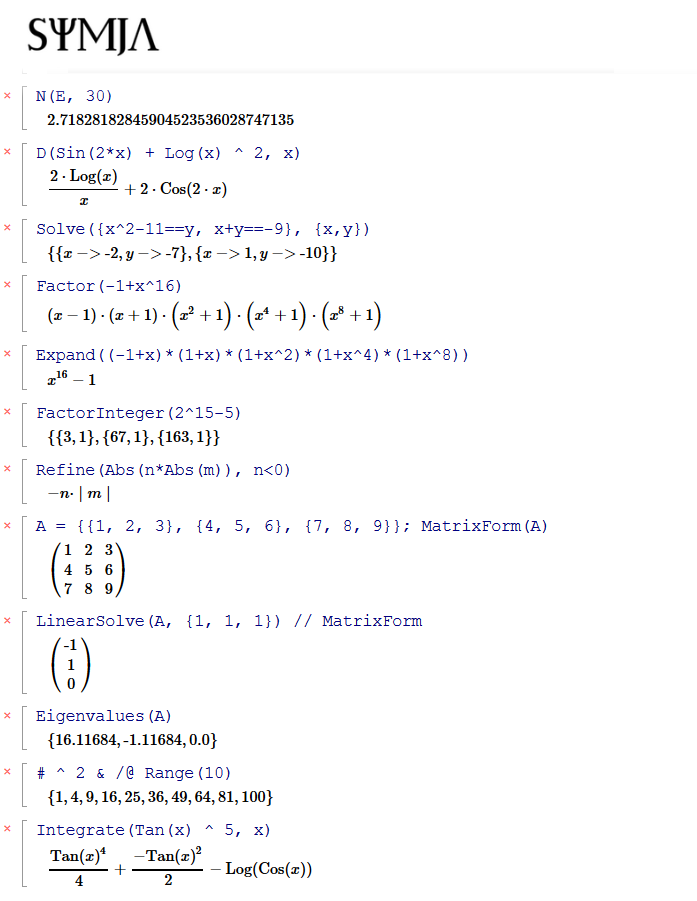Symja Library - Java Symbolic Math System for Android calculator
Note: this repository contains the Java 11 sources of the core modules. A minimal Android app example can be found in the symja-example repository :


Try the full-blown Android or iOS apps:
or help testing the latest Android BETA version or the web demo at matheclipse.org.
Read the Symja Manual :blue_book: for the description of the Symja language or browse the available functions :green_book: . We encourage everyone to participate in our Wiki.
🔧 Installation
The different kinds of installations are described in the Wiki Installation.
✨ Features
Features of the Symja language:
- arbitrary precision integers, rational and complex numbers. Polynomial, list functions and Associations
- differentiation, integration, equation solving, linear algebra, number theory, combinatorial, logic and polynomial functions...
- unified connectivity and interoperability through Symja functions for open source libraries like Hipparchus, Tablesaw, JGraphT, LogicNG, JAS Java Algebra System, apfloat...
- a general purpose Term Rewriting System and Pattern Matching engine
- use human readable math expression strings or the internal abstract syntax tree (AST) representation to code in Java. See the Unit test examples
- two Java servlet based notebook interfaces are available in the library. A Symja server for traditional math input and a MMA server for "Mathematica like syntax" input
- two REPLs are available in the library. A Console for standard math input and a MMAConsole for "Mathematica like syntax" input.
- new "script-functions" can be developed as Packages and loaded into the system
- developers can use Symja interactively in the Java jshell or with a call to to the JSON Web API Server
- the Rubi symbolic integration rules are used to implement the Integrate function, they can be systematically applied to determine the antiderivative of a wide variety of mathematical expressions
- compiling numeric functions with the Janino Java™ compiler
📦 Applications
-
Appengine web interface symjaweb.appspot.com - available as open source in this Github repository
-
Android App Calculator N+ on Google play store - available as open source in this Github repository provides an IDE mode to calculate arbitrary Symja expressions.
-
Eclipse EASE extension - use Symja as a REPL in Eclipse with this example Github repository which contains some Symja example scripts.
☕ Examples
Console user interface

HTML notebook interface





To get an idea of the kinds of expressions Symja handles, see the JUnit tests in this file.
Web Examples
Manipulate(Plot3D(Sin(a * x * y), {x, -1.5, 1.5}, {y, -1.5, 1.5}), {a,1,5})
Plot(Piecewise({{x^2, x < 0}, {x, x >= 0&&x<1},{Cos(x-1), x >= 1}}), {x, -2, 12})
package org.matheclipse.core.examples;
import org.matheclipse.core.eval.ExprEvaluator;
import org.matheclipse.core.expression.F;
import org.matheclipse.core.interfaces.IAST;
import org.matheclipse.core.interfaces.IExpr;
import org.matheclipse.core.interfaces.ISymbol;
import org.matheclipse.parser.client.SyntaxError;
import org.matheclipse.parser.client.math.MathException;
public class Example {
public static void main(String[] args) {
try {
ExprEvaluator util = new ExprEvaluator(false, (short) 100);
// Convert an expression to the internal Java form:
// Note: single character identifiers are case sensitive
// (the "D()" function identifier must be written as upper case
// character)
String javaForm = util.toJavaForm("D(sin(x)*cos(x),x)");
// prints: D(Times(Sin(x),Cos(x)),x)
System.out.println("Out[1]: " + javaForm.toString());
// Use the Java form to create an expression with F.* static
// methods:
ISymbol x = F.Dummy("x");
IAST function = F.D(F.Times(F.Sin(x), F.Cos(x)), x);
IExpr result = util.eval(function);
// print: Cos(x)^2-Sin(x)^2
System.out.println("Out[2]: " + result.toString());
// Note "diff" is an alias for the "D" function
result = util.eval("diff(sin(x)*cos(x),x)");
// print: Cos(x)^2-Sin(x)^2
System.out.println("Out[3]: " + result.toString());
// evaluate the last result (% or $ans contains "last answer")
result = util.eval("%+cos(x)^2");
// print: 2*Cos(x)^2-Sin(x)^2
System.out.println("Out[4]: " + result.toString());
// evaluate an Integrate[] expression
result = util.eval("integrate(sin(x)^5,x)");
// print: 2/3*Cos(x)^3-1/5*Cos(x)^5-Cos(x)
System.out.println("Out[5]: " + result.toString());
// set the value of a variable "a" to 10
// Note: in server mode the variable name must have a preceding '$'
// character
result = util.eval("a=10");
// print: 10
System.out.println("Out[6]: " + result.toString());
// do a calculation with variable "a"
result = util.eval("a*3+b");
// print: 30+b
System.out.println("Out[7]: " + result.toString());
// Do a calculation in "numeric mode" with the N() function
// Note: single character identifiers are case sensistive
// (the "N()" function identifier must be written as upper case
// character)
result = util.eval("N(sinh(5))");
// print: 74.20321057778875
System.out.println("Out[8]: " + result.toString());
// define a function with a recursive factorial function definition.
// Note: fac(0) is the stop condition.
result = util.eval("fac(x_Integer):=x*fac(x-1);fac(0)=1");
// now calculate factorial of 10:
result = util.eval("fac(10)");
// print: 3628800
System.out.println("Out[9]: " + result.toString());
function =
F.Function(F.Divide(F.Gamma(F.Plus(F.C1, F.Slot1)), F.Gamma(F.Plus(F.C1, F.Slot2))));
// eval function ( Gamma(1+#1)/Gamma(1+#2) ) & [23,20]
result = util.evalFunction(function, "23", "20");
// print: 10626
System.out.println("Out[10]: " + result.toString());
} catch (SyntaxError e) {
// catch Symja parser errors here
System.out.println(e.getMessage());
} catch (MathException me) {
// catch Symja math errors here
System.out.println(me.getMessage());
} catch (final Exception ex) {
System.out.println(ex.getMessage());
} catch (final StackOverflowError soe) {
System.out.println(soe.getMessage());
} catch (final OutOfMemoryError oome) {
System.out.println(oome.getMessage());
}
}
}
🔨 Maven Usage
How to use Maven is described in the Maven wiki page.
Getting started
First, you'll need a Java

 访问官网
访问官网 Github
Github Huggingface
Huggingface 文档
文档 论文
论文
















